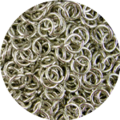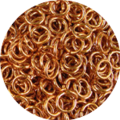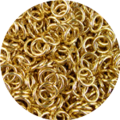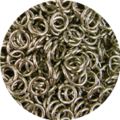What are the differences between your base metals?
We sell 5 different types of base metal: Aluminum, Copper, Jewelry Brass, Bronze, and Stainless Steel. Each has a different look, price point, ease of use, durability, and maintenance regiment.
Aluminum (ALUM)
 Description: Silver color, bright and very shiny. The aluminum we sell is actually referred to as bright aluminum (regular aluminum is not nearly as shiny and results in lots of black rub off within minutes of working with it!)
Description: Silver color, bright and very shiny. The aluminum we sell is actually referred to as bright aluminum (regular aluminum is not nearly as shiny and results in lots of black rub off within minutes of working with it!)
Price point: $
Ease of use: Very easy to work with (great for beginners)
Durability: Because aluminum is so easy to manipulate, you give up a little in the durability department. Not as durable as other metals (such as Jewelry Brass, Bronze, Stainless Steel, and Sterling Silver.) Very light.
Maintenance/Life expectancy: Easy to clean if it gets dirty, just wash in soapy water to bring back the shine. Over time, aluminum will corrode slightly, losing a bit of shininess. It stops this process once its surface layer (very thin) has corroded.
Hypoallergenic?: Not necessarily hypoallergenic however, it is widely accepted that aluminum is very poorly absorbed through the skin, so you do not need to worry about metal toxicity.
Alloy: 5356
Temper: Full Hard
Composition: Aluminum: 92.9 - 95.3%; Magnesium 0.8 - 1.2%; trace amounts possible of Chromium, Copper, Iron, Silicon, Zinc Manganese, Titanium
Purchase (bright) aluminum on our base metals page.
Copper (COPP)
 Description: Reddish finish, like a new penny.
Description: Reddish finish, like a new penny.
Price point: $$
Ease of use: Very easy to work with (great for beginners)
Durability: Not as durable as other metals (such as Jewelry Brass, Bronze, Stainless Steel, and Sterling Silver.) Has a nice weight. It is a weak metal, so you must be extra-gentle with copper chainmaille pieces, especially those with 20- or 22-gauge rings.
Maintenance/Life expectancy: Tarnishes fast. To clean, soak in pure lemon juice & salt for a few seconds. Store jewelry in Ziploc® bags to slow down tarnishing. Squeeze out as much of the air as possible from the bag before closing.
Hypoallergenic?: Some people do experience reactions to copper and other metals containing copper. This can result in skin turning green, etc.
Alloy: C110
Temper: 1/2 Hard
Composition: Copper: 99.9%
Purchase copper on our base metals page.
Jewelry Brass (JBRS)
 Description: Bright gold finish. Jewelry brass has a higher copper content than other brass. Some folks use other terms for jewelry brass, such as red brass, red bronze, or new gold, however note that those alloys may be exactly the same, or they may have 2-3 percent more copper.
Description: Bright gold finish. Jewelry brass has a higher copper content than other brass. Some folks use other terms for jewelry brass, such as red brass, red bronze, or new gold, however note that those alloys may be exactly the same, or they may have 2-3 percent more copper.
Price point: $$
Ease of use: Easy to work with (appropriate for most beginners.)
Durability: Durable and has a nice weight.
Maintenance/Life expectancy: Because it is an alloy of copper and zinc, brass patinas very fast. To clean, use any commercial jewelry cleaner that says it is safe for brass.
Hypoallergenic?: Because Jewelry Brass contains copper, people who have skin reactions to copper will likely also react to Jewelry Brass.
Alloy: C226
Temper: 1/2 Hard
Composition: Copper: 87%; Zinc: 13%
Purchase jewelry brass on our base metals page.
Bronze (BRNZ)
 Description: Close in color to copper (a little less red). If you like the look of aged copper but want a stronger metal, use bronze.
Description: Close in color to copper (a little less red). If you like the look of aged copper but want a stronger metal, use bronze.
Price point: $$
Ease of use: Can be challenging to work with, especially in 18g and 16g (not recommended for beginners.)
Durability: Durable and has a nice weight.
Maintenance/Life expectancy: Because this metal contains copper, it develops a patina fast. To clean, use any commercial jewelry cleaner that says it is safe for brass or copper.
Hypoallergenic?: Because bronze contains copper, people who have skin reactions to copper will likely also react to bronze.
Alloy: C150
Temper: 1/2 Hard
Composition: Copper: 92+%; Tin: approx 5% Phosphorus: 0.03 - 0.35% trace amounts of lead, Iron, Zinc
Purchase bronze on our base metals page.
Stainless Steel (SSTL)
 Description: Darker silver color, less of a mirror finish than aluminum but still shiny.
Description: Darker silver color, less of a mirror finish than aluminum but still shiny.
Price point: $$$
Ease of use: Can be very difficult to bend in gauges 18 and thicker. You'll need heavy-duty pliers (such as the Duck-Bill pliers. Steel is also fairly rough on pliers with Tool Magic; while the coating really helps keep your pliers from slipping, the coating starts to rip much sooner than with other metals. Saw-cut steel is expensive (it ain't easy cutting through steel with a saw!). This is NOT an appropriate metal for beginners, especially 18 and 16 gauge!
Durability: The most durable metal to work in and has a very nice weight.
Maintenance/Life expectancy: Steel will pretty much last forever and does not tarnish. Easy to clean if it gets dirty, just wash in soapy water to bring back the shine.
Hypoallergenic?: Stainless steel contains nickel, so those with nickel allergies often cannot wear stainless steel.
Alloy: 304
Temper: quarter-hard
Composition: Iron: approximately 69% Chromium: 19%; Nickel: 9.25%; Magnesium approximately 2%; Silicon: 1%; Carbon 0.08%; Phosphorous 0.045%; Sulfur: 0.03%
Purchase stainless steel on our base metals page.